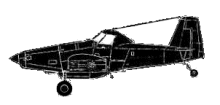
ASN Wikibase Occurrence # 386139
This information is added by users of ASN. Neither ASN nor the Flight Safety Foundation are responsible for the completeness or correctness of this information.
If you feel this information is incomplete or incorrect, you can submit corrected information.
| Date: | Saturday 10 March 2001 |
| Time: | 11:45 LT |
| Type: |  Air Tractor AT-802 A |
| Owner/operator: | Sarita Aerial Contractors Inc |
| Registration: | N6059L |
| MSN: | 802A-013 |
| Total airframe hrs: | 2520 hours |
| Engine model: | P&W PT6A-65AG |
| Fatalities: | Fatalities: 0 / Occupants: 1 |
| Aircraft damage: | Substantial |
| Category: | Accident |
| Location: | Maricopa, AZ -
 United States of America United States of America
|
| Phase: | Landing |
| Nature: | Agricultural |
| Departure airport: | Maricopa, AZ (NONE) |
| Maricopa, AZ (NONE) | |
| Investigating agency: | NTSB |
| Confidence Rating: |
The orientation of the runway was 340 degrees. The weather at the nearest reporting station indicated that the winds were from 100 degrees at 6 knots. This would have resulted in a 4-knot rear quartering tailwind and a 2-knot crosswind from the right. Using the performance data listed in the airplane's pilot operating handbook, the landing distance was calculated to be 2,109 feet, without using reverse. The Gila River West runway on which the accident occurred was 2,400 feet long. Assuming that the airplane was flown at the reference speed of 73 knots, with no wind, and touched down on the threshold, there would have been only 291 feet remaining on the runway. The tailwind present at the time of the accident would have increased the landing distance required, and thereby reducing the available runway. The presence of an irrigation sump at the end of the runway would have eliminated any margin for error, and made it impossible to overrun the runway safely. The placement of a truck along the side of the runway at the departure end further limits available options in the event of a long landing or overrun. Under the conditions at the time of the accident, there would have been no allowance for error either in pilot technique, or in a real or perceived mechanical malfunction. These factors would force the pilot to make sudden, last minute maneuvers to avoid obstacles at the end of the runway. During an engine inspection, performed by factory personnel, and witnessed by an inspector from the Federal Aviation Administration Southwest Manufacturing District Office (FAA MIDO-41), the engine was operated up to 30 percent of its power range with no anomalies noted. The power was reduced to idle several times and the propeller did not feather. The propeller operated throughout the operating range, including beta, with no defects noted. It was noted that with the power lever in the full aft position, the beta plunger was slightly depressed. This may have been enough to allow the propeller to go slightly past the low pitch stop, toward reverse, when the power lever was pulled back to the idle position. It was observed that rubbing had occurred between the two controls. The FAA inspector and assisting personnel attempted to force the throttle lever to move the propeller control lever aft. The two levers did move aft together, only when the power lever was pulled inboard against the propeller control lever. However, the propeller control lever could not be made to move past the feather detent. If the throttle had been closed, the propeller would move to the low pitch (high rpm) position even with the propeller control pulled aft to the control stop.
Probable Cause: Inadequate selection of landing facilities and improper placement of vehicles near the runway. An additional factor was the use of a runway which resulted in a downwind landing.
Accident investigation:
 |
|
Sources:
NTSB LAX01LA114
Revision history:
| Date/time | Contributor | Updates |
|---|---|---|
| 05-Apr-2024 11:33 | ASN Update Bot | Added |
Corrections or additions? ... Edit this accident description
The Aviation Safety Network is an exclusive service provided by:


 ©2024 Flight Safety Foundation
©2024 Flight Safety Foundation